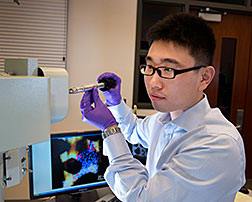- Number 415 |
- June 9, 2014
Scientists pinpoint creeping nanocrystals behind lithium-ion battery degradation

Huolin Xin – BNL.
Batteries do not age gracefully. The lithium ions that power portable electronics cause lingering structural damage with each cycle of charge and discharge, making devices from smartphones to tablets tick toward zero faster and faster over time. To stop or slow this steady degradation, scientists track and tweak the imperfect chemistry of lithium-ion batteries with nanoscale precision.
In two recent Nature Communications papers, scientists from several DOE national laboratories—Lawrence Berkeley, Brookhaven, SLAC, and the National Renewable Energy Laboratory—collaborated to map these billionths-of-a-meter dynamics.
“We discovered surprising and never-before-seen evolution and degradation patterns in two key battery materials,” said Huolin Xin, a materials scientist at Brookhaven Lab’s Center for Functional Nanomaterials (CFN) and coauthor on both studies. “Contrary to large-scale observation, the lithium-ion reactions actually erode the materials non-uniformly, seizing upon intrinsic vulnerabilities in atomic structure in the same way that rust creeps unevenly across stainless steel.”
Xin used world-leading electron microscopy techniques in both studies to directly visualize the nanoscale chemical transformations of battery components during each step of the charge-discharge process. In an elegant and ingenious setup, the collaborations separately explored a nickel-oxide anode and a lithium-nickel-manganese-cobalt-oxide cathode—both notable for high capacity and cyclability—by placing samples inside common coin-cell batteries running under different voltages.
“Armed with a precise map of the materials’ erosion, we can plan new ways to break the patterns and improve performance,” Xin said.
Chinks in Nano-Armor
For the nickel-oxide anode, researchers submerged the batteries in a liquid organic electrolyte and closely controlled the charging rates, stopping at predetermined intervals to extract and analyze the anode. Xin and his collaborators then rotated 20-nanometer-thick sheets of the material inside a carefully calibrated transmission electron microscope (TEM) at CFN to catch the contours from every angle—a process called electron tomography.
The scientists then used a suite of custom-written software to digitally reconstruct the three-dimensional nanostructures with single-nanometer resolution. Surprisingly, the reactions sprang up at isolated spatial points rather than sweeping evenly across the surface.
“Consider the way snowflakes only form around tiny particles or bits of dirt in the air,” Xin said. “Without an irregularity to glom onto, the crystals cannot take shape. Our nickel oxide anode only transforms into metallic nickel through nanoscale inhomogeneities or defects in the surface structure, a bit like chinks in the anode’s armor.”
The electron microscopy provided a crucial piece of the larger puzzle assembled in concert with Berkeley Lab materials scientists and soft x-ray spectroscopy experiments conducted at SLAC’s Stanford Synchrotron Radiation Lightsource (SSRL).
Rock-Salt Buildups
In the other study, scientists sought the voltage sweet spot for the high-performing lithium-nickel-manganese-cobalt-oxide (NMC) cathode.
The results hinged on intrinsic material qualities and the structural degradation caused by cycles at 4.7 volts and 4.3 volts, as measured against a lithium metal standard.
As revealed through another series of coin-cell battery tests, 4.7 volts caused rapid decomposition of the electrolytes and poor cycling. A 4.3-volt battery, however, offered a much longer cycling lifetime at the cost of lower storage and more frequent recharges.
In both cases, the chemical evolution exhibited sprawling surface asymmetries, though not without profound patterns.
“As the lithium ions race through the reaction layers, they cause clumping crystallization—a kind of rock-salt matrix builds up over time and begins limiting performance,” Xin said. “We found that these structures tended to form along the lithium-ion reaction channels, which we directly visualized under the TEM. The effect was even more pronounced at higher voltages, explaining the more rapid deterioration.”
Identifying this crystal-laden reaction pathways hints at a way forward in battery design.
“It may be possible to use atomic deposition to coat the NMC cathodes with elements that resist crystallization, creating nanoscale boundaries within the micron-sized powders needed at the cutting-edge of industry,” Xin said. “In fact, Berkeley Lab battery experts Marca Doeff and Feng Lin are working on that now.”
Complementary research was conducted at SLAC’s SSRL and Berkeley Lab’s National Center for Materials Synthesis, Electrochemistry, and Electron Microscopy, with computational support from the National Energy Research Supercomputer Center and the Extreme Science and Engineering Discovery Environment.
Research at Brookhaven Lab’s CFN and SLAC’s SSRL—both DOE user facilities—was supported by DOE’s Office of Science. The NMC work was also supported through the Batteries for Advanced Transportation Technologies (BATT) program funded by DOE’s Office of Energy Efficiency and Renewable Energy and led by Berkeley Lab.Submitted by DOE’s Brookhaven National Laboratory
